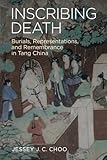Inscribing Death : Burials, Representations, and Remembrance in Tang China / Jessey J. C. Choo.
Material type: TextPublisher: Honolulu : University of Hawaii Press, [2022]Copyright date: ©2022Description: 1 online resource (304 p.) : 1 b&w illustrationContent type:
TextPublisher: Honolulu : University of Hawaii Press, [2022]Copyright date: ©2022Description: 1 online resource (304 p.) : 1 b&w illustrationContent type: - 9780824877330
- 9780824893224
- Burial -- China -- History -- To 1500
- Collective memory -- China -- History -- To 1500
- Funeral rites and ceremonies -- China -- History -- To 1500
- Mourning customs -- China -- History -- To 1500
- RELIGION / History
- Asia
- Buddhism
- China
- History
- Religion
- Rituals & Practice
- Tang China
- burial
- death rites
- memory
- GT3283.A2 C45 2022
- online - DeGruyter
| Item type | Current library | Call number | URL | Status | Notes | Barcode | |
|---|---|---|---|---|---|---|---|
 eBook
eBook
|
Biblioteca "Angelicum" Pont. Univ. S.Tommaso d'Aquino Nuvola online | online - DeGruyter (Browse shelf(Opens below)) | Online access | Not for loan (Accesso limitato) | Accesso per gli utenti autorizzati / Access for authorized users | (dgr)9780824893224 |
Frontmatter -- Contents -- Acknowledgments -- Conventions, Translations, and Abbreviations -- Dynastic Chronology -- Tang Dynasty Rulers and Reign-Periods -- Introduction -- 1. The Rise and Normalization of Familial Joint-Burial -- 2. Spousal Joint- and Disjoint-Burials -- 3. Burial Divinations -- 4. The Hun-Summoning Burial -- Epilogue. The Speakers for the Dead -- Appendix: The Muzhiming of the Late [Lady] Zhangsun -- Notes -- References -- Index -- About the Author
restricted access online access with authorization star
http://purl.org/coar/access_right/c_16ec
This nuanced study traces how Chinese came to view death as an opportunity to fashion and convey social identities and memories during the medieval period (200–1000) and the Tang dynasty (618–907), specifically. As Chinese society became increasingly multicultural and multireligious, to achieve these aims people selectively adopted, portrayed, and interpreted various acts of remembrance. Included in these were new and evolving burial, mourning, and commemorative practices: joint-burials of spouses, extended family members, and coreligionists; relocation and reburial of bodies; posthumous marriage and divorce; interment of a summoned soul in the absence of a body; and many changes to the classical mourning and commemorative rites that became the norm during the period. Individuals independently constructed the socio-religious meanings of a particular death and the handling of corpses by engaging in and reviewing acts of remembrance. Drawing on a variety of sources, including hundreds of newly excavated entombed epitaph inscriptions, Inscribing Death illuminates the process through which the living—and the dead—negotiated this multiplicity of meanings and how they shaped their memories and identities both as individuals and as part of collectives. In particular, it details the growing emphasis on remembrance as an expression of filial piety and the grave as a focal point of ancestral sacrifice. The work also identifies different modes of construction and representation of the self in life and death, deepening our understanding of ancestral worship and its changing modus operandi and continuous shaping influence on the most intimate human relationships—thus challenging the current monolithic representation of ancestral worship as an extension of families rather than individuals in medieval China.
Mode of access: Internet via World Wide Web.
In English.
Description based on online resource; title from PDF title page (publisher's Web site, viewed 29. Mai 2023)


